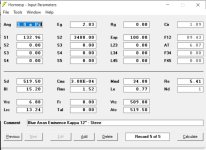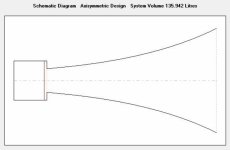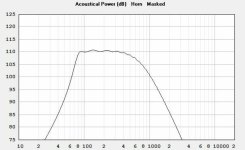Thank you!You have the same compression in both versions, but the 2nd version should be modelled using the Vtc tab to allow for the different volumes, instead of modelling the throat chamber as part of the horn.
I had not touched Vtc from the default value...
Now I have used the Vtc tab. Vtc of one driver comes out as 375cm3. Should I use 750cm3 in this model?
I used Atc=2xSd for no compression. Is this correct?
I also adopted exponential flare.
thoughts?
thanks again!!
750cm3 is correct for 2 drivers.
If area throat chamber is the same as 2xsd then yes. If throat area matches the sd of 2 (round) drivers then the drivers will be partially covered due to the 'wasted' space between drivers. (throat would be whatever ratio you want, but if drivers are touching 1 above the other then a rectangle would be 40cm high by 11cm wide)
With exponential just do s1=440, s2=3750 and set the length to 110 exp. Leave s2 etc at 0.0
If area throat chamber is the same as 2xsd then yes. If throat area matches the sd of 2 (round) drivers then the drivers will be partially covered due to the 'wasted' space between drivers. (throat would be whatever ratio you want, but if drivers are touching 1 above the other then a rectangle would be 40cm high by 11cm wide)
With exponential just do s1=440, s2=3750 and set the length to 110 exp. Leave s2 etc at 0.0
Thank you!!!
I had that wrong. I didn't intend to include compression but didn't realize S1 was for both drivers together...now that I think about it...it should have been obvious. Oh well.
Now with S1=Sd.
View attachment 1167609
Yeap. Not trying to cheat it. How long was your exponential horn for the 12" to cover 90 to 350Hz?
Attachments
If efficiency is not very important because you have plenty of power, and controlled directivity below ~500hz is not practical (home situation), are there any reasons to go for horn loaded bass?
I know it's debatable, but it's there any consensus on horn loaded bass sounding different vs direct radiators?
IMO, horn loaded systems sound different from non-horn-loaded, but that usually involves only midrange and highs
I know it's debatable, but it's there any consensus on horn loaded bass sounding different vs direct radiators?
IMO, horn loaded systems sound different from non-horn-loaded, but that usually involves only midrange and highs
Horn loaded bass sound different because a horn couples to the air in your room in a different way (acoustical impedance matching) and because of the efficiency, the distortion has a much lower value, as the driver does not have to work that hard for the same sound pressure.
The 8PE21 is good for 4 times it's Xmax. IIRC, JLH didn't use it above 100Hz since a tapped horn isn't good with higher frequencies. I think it was about 40 litres but I can't remember the length.I believe that was JLH using it in a subwoofer. Very knowledgeable! I'm far from that. Do you know how long was that horn, or how high did he play it?
When adjusting a front horn with this driver you'll find it's frequency limits in hornresp because it won't be pushed down too far without losing the horn's performance. For tractrix, this happens around 145Hz cutoff, and if you go a little higher or lower the adjustments you make to optimise it simply bring it effectively back to that same place, so that's where it wants to be. I also tried conical and went larger at the mouth but no longer than you have.
I remember one established horn expert saying to me at the start of my horn journey, before I'd made anything, regarding playback, "you haven't heard bass until you've heard horn bass"🙂
Thanks for including your model!
I noticed you use Fr=0. Means no lining in the rear chamber, right?
Also changed to the same mouth size you use.
Increased Atc to account for what you mentioned ("wasted" area), and also introduced some compression (about 2:1).

looks smoother and more extended, at least in the modelling.
How low would you cross this horn from you can see here? Of course measurements post building will dictate that, but wondering if 90Hz seems reasonable or there is a rule of thumb that suggest it should be higher than what the simulation shows.
I noticed you use Fr=0. Means no lining in the rear chamber, right?
Also changed to the same mouth size you use.
Increased Atc to account for what you mentioned ("wasted" area), and also introduced some compression (about 2:1).
looks smoother and more extended, at least in the modelling.
How low would you cross this horn from you can see here? Of course measurements post building will dictate that, but wondering if 90Hz seems reasonable or there is a rule of thumb that suggest it should be higher than what the simulation shows.
This reminds me of a concern I had: Would a midbass horn crossed at 90Hz to 4 sealed 12" subs sound good, or should I be thinking about a horn sub? The latter I don't see happening, so maybe that's a good reason to go with a large direct radiator for midbass.I remember one established horn expert saying to me at the start of my horn journey, before I'd made anything, regarding playback, "you haven't heard bass until you've heard horn bass"🙂
Horn midbass.
Eventhen you may need to be 10' away to feel, perceive it.
Djk mentioned something about particle wave vs spl (sound pressure wave).
Something about needing to be 1\4 wavelength away for the bass to develop, or partial wave lining up with the pressure wave.
Bruce Edgar mentioned no bass until you are 10' from his bass horn.
And I think Wayne parnham says this can do with horns standing waves interacting with the room differently.
I had a w-bin misused as a subwoofer.
That felt more impactful 1/2, 3/4, and back wall versus 4x18's.
And the 18s in room had a huge dead spot at 3/4 distance into the 3 walled brick slab floor.
And when used upstairs, I've never had slamming drums before or after.
But standing close, there was no bass compared to a direct radiator.
I think the leveraged air of a 4-6 ft2 bass horn mouth moves the air extremely different than four smaller circles.
Couples better ?
Similar to how I preferred my 2x18 ppsl sub over 4x12 ppsl, maybe.
Slam can also be integration.
I think slam goes way crossing 100-300hz, pure wrap of upper harmonics not lining up.
Dim would pull the mid fuse on a klipschorn and its Slam went away.
Eventhen you may need to be 10' away to feel, perceive it.
Djk mentioned something about particle wave vs spl (sound pressure wave).
Something about needing to be 1\4 wavelength away for the bass to develop, or partial wave lining up with the pressure wave.
Bruce Edgar mentioned no bass until you are 10' from his bass horn.
And I think Wayne parnham says this can do with horns standing waves interacting with the room differently.
I had a w-bin misused as a subwoofer.
That felt more impactful 1/2, 3/4, and back wall versus 4x18's.
And the 18s in room had a huge dead spot at 3/4 distance into the 3 walled brick slab floor.
And when used upstairs, I've never had slamming drums before or after.
But standing close, there was no bass compared to a direct radiator.
I think the leveraged air of a 4-6 ft2 bass horn mouth moves the air extremely different than four smaller circles.
Couples better ?
Similar to how I preferred my 2x18 ppsl sub over 4x12 ppsl, maybe.
Slam can also be integration.
I think slam goes way crossing 100-300hz, pure wrap of upper harmonics not lining up.
Dim would pull the mid fuse on a klipschorn and its Slam went away.
Last edited:
Depends; with four, recommend arranging them per Dr. Geddes' multiple subs doc since properly coupled to the room it can potentially make for a decent conical horn substitute due to room gain if the XO is kept low enough.Would a midbass horn crossed at 90Hz to 4 sealed 12" subs sound good, or should I be thinking about a horn sub? The latter I don't see happening, so maybe that's a good reason to go with a large direct radiator for midbass.
Re horn sub; in your case, theoretically the 'Hot Ticket' is to use a corner (parabolic horn assuming a parallel floor/ceiling, sloped = conical) array, so stack your subs, use industrial strength Velcro* to attach a false floor/ceiling baffle with something to ~100% seal the rear off or as I did, just took wrapped rolls of ceiling joist FB insulation, sliced several top/bottom panels out of the plastic wrapping and stacked them in the cavity as a 'good enough' resonant cavity trap if your subs require cooling.
Compression horns roll off at ~24 dB/octave (2nd order), so in theory can be XO'd at its -6 dB point assuming it will never 'feel' > minimal max power. In short for HIFI/HT apps, best to experiment or just XO a half octave higher (Fb/0.707).
* From sad experience, do not make long strips, but a bunch of short tabs spaced apart enough to allow most/all of your fingers to ~easily pry it off.
Yeah, all so true! And with more Qs than I can keep up with these days, thanks for pointing out the 'truth' of compression horns in an acoustically small bounded space hence the big Edgar horn being floor loaded with a mass loading plug to make it more a fancy BP4 box alignment than true horn. Altec's short horns are pretty much the limit in most HIFI apps I've experienced and even the few big high end (5.1) HTs I've been exposed to really only needed a 500 Hz (15") - 800 Hz (12") XO WHW sealed or dipole in lieu of 'full tilt boogy' JBL cinema systems normally spec'd/demanded at least locally.Bruce Edgar mentioned no bass until you are 10' from his bass horn.
And I think Wayne parnham says this can do with horns standing waves interacting with the room differently.
Similar to how I preferred my 2x18 ppsl sub over 4x12 ppsl, maybe.
Slam can also be integration.
Not surprised as the 18's have a bit more radiating area plus closer coupling over a wider BW for better XO/room integration, though in theory if the four were optimized per Dr. Geddes or similar, then it should prevail overall if the XO point/slope met the needs of the app.
Wow! As a general rule we're limited to the driver's upper/lower mass corner, though with such a wide one and considering that THs are ~1.5 - 2 octaves max this limits it to ~123 Hz, so with DSP to get the desired roll off slope it should in theory sound fine assuming it's located for best overall in room response.The 8PE21 is good for 4 times it's Xmax. IIRC, JLH didn't use it above 100Hz since a tapped horn isn't good with higher frequencies. I think it was about 40 litres but I can't remember the length.
Anyway, don't recall ever seeing JLH's TH, but FWIW my default 2:1 CR DTS TH sim sure looks good to ~123 Hz, though how it would sound at 4x Xmax 😱 remains to be seen.
Attachments
Increased Atc to account for what you mentioned ("wasted" area), and also introduced some compression (about 2:1).
Moving the mouse pointer over S1 or Sd will display the compression ratio in the status bar panel at the bottom of the window. In the case of an offset driver move the mouse pointer over S2 rather than S1.
In certain applications it sounds fine. It was probably unwise of me to make such a general statement. Xvar for this driver is 4.5mm and IIRC it has been reported as being around the 10% distortion mark.. like the typical limit given with certain low feedback amplifiers with a generally simple distortion profile.though how it would sound at 4x Xmax 😱
OK, then my 220 W/2pi sim becomes 22 W/2pi, though in 1 pi it sims a respectable 115 dB/m and 120 dB in a really solid corner; not too shabby for ~60 L.
Because I use a JBL 2482 phenolic, 2" throat compression driver, on tractrix horn above the mid bass horns, I wanted to get as low as possible with them.Thanks for including your model!
I noticed you use Fr=0. Means no lining in the rear chamber, right?
Also changed to the same mouth size you use.
Increased Atc to account for what you mentioned ("wasted" area), and also introduced some compression (about 2:1).
View attachment 1167668
looks smoother and more extended, at least in the modelling.
How low would you cross this horn from you can see here? Of course measurements post building will dictate that, but wondering if 90Hz seems reasonable or there is a rule of thumb that suggest it should be higher than what the simulation shows.
I cross at 350, has been as low as 330.
I wouldn't want to play the mid bass horn anything like as high as to where they model well though.
Get so much more out of a large format compression driver tone and speed wise.
I've tried lining / no lining.
Also a smaller chamber volume seems to work better in general.
I tune to room size where possible, measuring my way.
I'm going to be building a 1.7m long exponential pair soon.
Ideally to use the same Eminence 12" driver.
Models down to 52Hz! Easy up to 350Hz. Nice.
Will still fit through a regular door..
Agree to what some have said about slam and being farther away from the horns.
Close up they don't hit you in the chest like an array of passive radiators.
For me they make up for that with the tonal texture, speed and control they exhibit.
The big conicals I had were in between. Too big a mouth though 😂
My pair of tapped horns do hit you on the deep stuff though🙂
Added: will say it again - what a great tool Hornresp is - thank you David👍
Last edited:
Great discussion. Plenty to digest.
My 4 sealed 12" subs are indeed uses á-la Geddes: in mono and towards flattening the response around the room, but placement is dictated by decor layout because it's the living room, so I use a MiniDSP and MultiSub Optimizer to get to that flat response. Building horn subs is beyond what I can tackle: it's a concrete apartment building. Large as far as apartment go, but an apartment nevertheless and concrete so no way to build them into the walls.
The discussion about needing to be 10' away from the mouth to hear bass (say at 90Hz) is making me pause. The listening space is about 17'x17' opening to another 17'. If I assume the horns aligned along the diagonals of the 17x17' they would take about 4' from the corner. Plus 10' for the bass to develop that means I would be able to listen to music on a couch against the back wall (actually 4 feet away from the wall, so maybe I could place a chair there for listening).
I'm more than OK having a midbass horn from 80-90 Hz up to 300-400Hz and have a midrange horn from there. But wondering if midbass horn or 15-18" direct radiator might be best for my case?
My 4 sealed 12" subs are indeed uses á-la Geddes: in mono and towards flattening the response around the room, but placement is dictated by decor layout because it's the living room, so I use a MiniDSP and MultiSub Optimizer to get to that flat response. Building horn subs is beyond what I can tackle: it's a concrete apartment building. Large as far as apartment go, but an apartment nevertheless and concrete so no way to build them into the walls.
The discussion about needing to be 10' away from the mouth to hear bass (say at 90Hz) is making me pause. The listening space is about 17'x17' opening to another 17'. If I assume the horns aligned along the diagonals of the 17x17' they would take about 4' from the corner. Plus 10' for the bass to develop that means I would be able to listen to music on a couch against the back wall (actually 4 feet away from the wall, so maybe I could place a chair there for listening).
I'm more than OK having a midbass horn from 80-90 Hz up to 300-400Hz and have a midrange horn from there. But wondering if midbass horn or 15-18" direct radiator might be best for my case?
- Home
- Loudspeakers
- Multi-Way
- (mid)Bass horns and partially covered drivers


